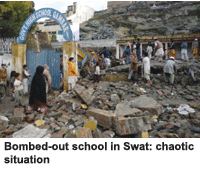Schools across the conflict-zone in Pakistan’s northern areas are open, but many are damaged, and there are concerns about the quality of education and funding for camp schools for displaced children. In the Swat district, where Taliban militants destroyed 356 schools according to government officials, pupils are back in class. “My son’s school was badly damaged in 2009 by fire. Now the children sit outdoors, or on the floors of gutted classrooms that lack walls or roofs,” Imdad Hassan, from the town of Kabal in Swat, told IRIN News.
Many schools are being operated in similar fashion after they were re-opened last year. The situation is also chaotic in the Bajaur tribal area, where schools re-opened in March. “The school infrastructure has been badly damaged. Records have been destroyed and many buildings are in ruins,” says Ibrash Pasha, who works in Dir district in the North West Frontier Province (NWFP) with Khwendo Kor, an NGO which promotes schools for girls. According to Pasha, parents are eager to educate children but are hampered by the slow effort to restore buildings.
 “The sight of the bombed-out school buildings scares my daughters. They don’t like to go there. In private schools such as the one they attend, some of the teachers have not returned either, preferring to stay away from Swat or give up work,” says Dilbahar Bibi, the mother of three school-going daughters.
“The sight of the bombed-out school buildings scares my daughters. They don’t like to go there. In private schools such as the one they attend, some of the teachers have not returned either, preferring to stay away from Swat or give up work,” says Dilbahar Bibi, the mother of three school-going daughters.
“Frankly there is chaos. Schools have no funding and massive work is needed to restore buildings. Even furniture not destroyed by militants has been vandalized,” an education official who asked not to be named told IRIN. He said “huge amounts of money” is needed to restore the education infrastructure.
There is also a risk that 19,000 displaced children may be affected by lack of funding to run schools at camps for internally displaced persons (IDPs). Fawad Ali Shah, an Islamabad-based education officer (emergency) of the UN Children’s Fund (Unicef), says that while education needs in camps, host communities and areas of return are being responded to, “projects in the PHRP (Pakistan Humanitarian Response Plan) 2010, for interventions in camps have received very limited funding”. “This means some very critical educational activities in IDP camps as well as in host communities have been affected. The situation is getting even more critical in view of the ever-rising numbers of IDPs coming in to Kohat, Hangu and other southern districts (of NWFP). It is likely Unicef may have to scale down operations if funding for this project does not materialise soon,” says Shah.
In a statement issued in Geneva on April 16, Unicef said it has received only 6 percent of the US$1.4 million (Rs.6.4 crore) it had requested for educating children in IDP camps. Comments Pirkko Heinonen, Unicef’s acting deputy representative for Pakistan: “At present we only have funding to support primary schools in one camp, Jalozai, benefiting 5,000 children, till the end of the year.”
Of the 1.3 million people still displaced by conflict in NWFP and tribal areas, 60 percent are estimated by Unicef to be children.
(Excerpted and adapted from www.irinnews.org)